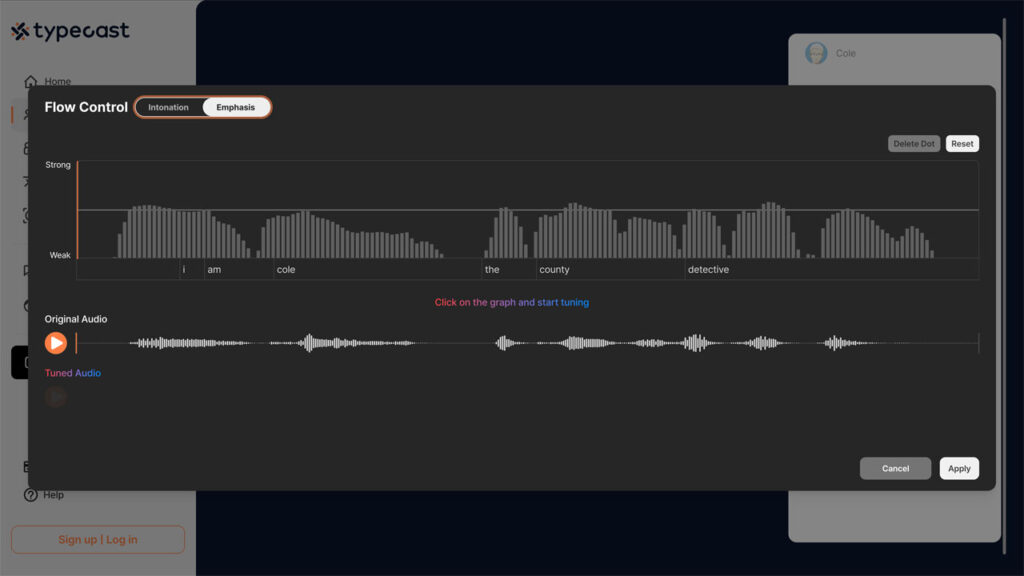As AI text-to-speech (TTS) continues to grow in online popularity, so does its need to evolve with the ever changing needs of users, business, and mediums. One avenue in this pursuit has been the development and implementation of different accents within text-to-speech tools, as well as different languages altogether.
This makes sense since TTS tools are becoming a worldwide phenomenon enjoyed by many in countries such as India and the Philippines.
As well as expanding languages, the demand for more regional dialects and accents is something that we at Typecast have also noticed from our users.
Therefore, TTS tools that meet these demands will likely become the most successful.
If you’re new to text-to-speech and want to learn more, check out our detailed guide on How to Use AI Text-to-Speech Online here.
In this article, we’ll cover a few different text-to-speech applications within the realm of language and accents, and how you can use these tools to benefit you, your personal projects, or businesses.
Using different accents in text-to-speech
Accents can significantly enhance the listener’s connection to any material, making it feel more familiar and engaging.
Whether it’s for educational purposes, marketing, or entertainment, the ability to choose from various accents allows creators to cater to audiences of specific regional or cultural backgrounds to create a more immersive experience.
This not only helps in delivering content more effectively but also fosters a sense of familiarity and may remove any bias that may be projected towards ‘outside,’ or foreign content, products, or companies.
As TTS technology continues to advance, the range of available accents expands, offering more choices than ever before.
Check out Our Top 5 Text-to-Speech Accents in regards to our own text-to-speech tool, and the accents that we like to use in our own content.
The use of Japanese with text-to-speech

The use of Japanese in text-to-speech technology has become increasingly significant, particularly as interest in Japanese culture and language grows globally.
TTS systems that support Japanese are becoming a valuable tool for language learners, content creators, and businesses.
These systems can capture the nuances of the Japanese language, including pitch accents and varying intonations, which are crucial for conveying meaning and emotion.
Moreover, text-to-speech technology can aid in accessibility by providing audio support for Japanese text, benefiting individuals with visual impairments or reading difficulties.
It can also enhance educational tools, allowing learners to practice their listening skills and pronunciation with authentic Japanese-sounding voices.
Our guide on How to Use an AI Japanese Voice Generator is great for those looking to further explore the capabilities of AI-generated Japanese voices and how to use them.
Achieving a British accent in text-to-speech

Ever since globally popular shows such as Downton Abbey and The Crown first aired, British accents have received a slight revival in use when it comes to voice over work and general content creation.
This has made the British accent in text-to-speech technology a popular choice for many users seeking to replicate the authenticity and appeal of these British voice overs for their audio content.
The distinct characteristics of a British accent—such as its varied regional pronunciations, intonation, and rhythm—can significantly influence how messages are received by listeners.
Whether for narrating audiobooks, creating engaging marketing materials, or enhancing educational resources, a British accent can lend a sophisticated touch to the delivery.
TTS tools that offer British accents allow creators to tap into a rich linguistic heritage, making their content more relatable for audiences familiar with British English.
The availability of different British accents—ranging from Received Pronunciation to regional dialects—provides users with the flexibility to choose the voice that best fits their project’s tone and context.
If you’re a fan of popular British sitcoms such as The IT Crowd or historic dramas such as Bridgerton then our own British AI voice actors may be of interest to you.
The rise of Korean AI voices in online media and the entertainment industry

The rise of Korean AI voices in online media and the entertainment industry reflects the growing global interest in Korean culture, particularly through music, film, and television.
As K-pop and Korean dramas gain immense popularity worldwide, the demand for authentic Korean voices in various applications has surged.
Some AI voice technology such as Typecast offer the most accurate Korean accent generator on the internet, enabling creators to produce content that resonates with both domestic and international audiences.
These AI voices are being utilized in a range of settings, from video games and animations to educational platforms and marketing campaigns.
Their ability to convey emotions and cultural nuances makes them a valuable tool for engaging listeners and enhancing storytelling.
Moreover, the incorporation of Korean AI voices helps bridge language barriers, making Korean content more accessible to non-native speakers, especially those in the west.
Text-to-speech for Spanish-speaking users

With millions of Spanish speakers worldwide, text-to-speech tools that support the language can provide significant benefits in education, entertainment, and business.
These systems allow users to convert written Spanish text into natural-sounding speech, making it easier for individuals to engage with content in their native language.
The availability of various Spanish accents and dialects enhances the versatility of TTS applications, allowing creators to tailor their output to specific audiences, whether in Spain, Latin America, or other Spanish-speaking regions.
This adaptability ensures that the pronunciation and intonation resonate with listeners, fostering a more immersive experience.
For those looking to delve deeper into how to effectively utilize Spanish text-to-speech technology, you can go to our comprehensive how-to guide How to Use Spanish Text-to-Speech here.
Changing the tone of voice in text-to-speech

Changing the tone of voice in text-to-speech systems allows for a more personalized and engaging user experience.
Different tones can convey various emotions, such as excitement, seriousness, or calmness, and can significantly impact how content is perceived by listeners.
By adjusting the tone, TTS can better match the context of the message, enhancing the overall effectiveness of communication.
TTS tools now offer a range of voice types, each with unique tonal qualities, enabling users to select the most appropriate voice for their specific needs.
Whether for educational materials, customer service interactions, or storytelling, the ability to change tone adds a layer of adaptability that makes TTS technology more versatile and user-friendly.
For those interested in learning how to effectively change the tone of voice types in text-to-speech, you can learn more in our how-to guide TTS: How to Change the Tone of Voice Types here.









